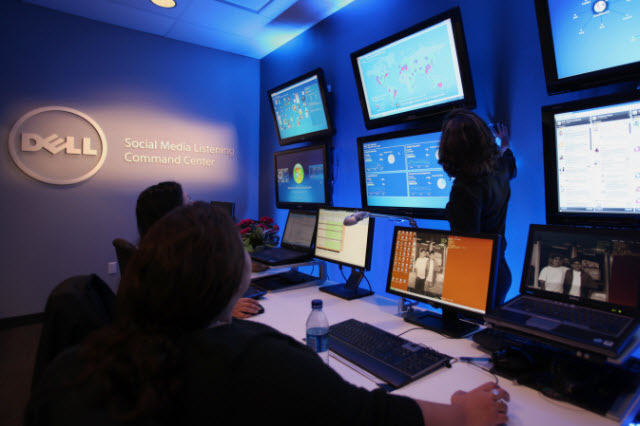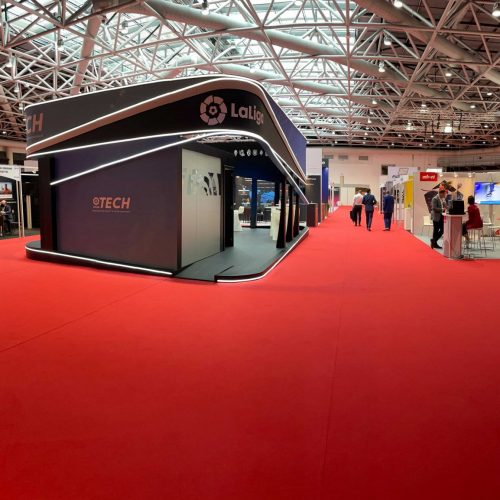Social Media Command Centres – The Future or PR Stunt?
The building of ‘command centres’ for social media has been a phenomenon we have seen develop in the US over the past couple of years. The latest team to build one are NBA team Sacramento Kings who made their big announcement yesterday.
This new epicenter of the Kings activities will be located on one of the courtside corners of the arena, enabling those updating fans on the Kings numerous pages to be as close to the action as possible. As a nice touch they are also giving fans the opportunity to upgrade their seats to one of the six designated seats by way of their official Kings app.
“Since the advent of social media, the Sacramento Kings and its fanbase have been active participants in the ever-evolving online conversation,” said Kings Senior Vice President of Broadcasting, New Media and Brand Development Craig Amazeen. “Through Kings Social Media Headquarters, we aim to shine the spotlight on and reward our social-media-savy Sixth Man, as well as showcase the variety of ways in which fans can enrich their 24/7/365 Kings experience in and out of the arena.”
Going back to where all this began….. one of the first to put it into action was Gatorade in the summer of 2010. Their ‘Mission Control’ was built with partners Radian 6 and IBM to give them round-the-clock immediate access to data on who was talking about them and where, as well as competitors.
[youtube]http://youtu.be/InrOvEE2v38[/youtube]
What started out as a very much a PR stunt, one which worked very well and continues to do so, has become talked about in a much more serious way as time has gone by. Yesterday I was invited to take part in a really interesting event here in London called Inbound Marketing 2012. During this one of the speakers, an american, spoke about command centres and how they are important to marketeers if you want to be about the ‘now’.
Many of us look at the past for insights or plan what we are going to do in the future, but few see what is happening now and react accordingly. There are many opportunities to truly engage and be useful to consumers by being on-the-ball and have the ability to be flexible and responsive. But without the ability to monitor what is happening, how can you react?
Since Gatorade we have seen the likes of Dell (in Dec 2010) and in March this year the American Red Cross decided to do the same. Clemson University built a listening centre with the help of Dell and Radian 6 and use the data to conduct research experiements. And Edelman Digital launched their ‘social intelligence command centre’ (SICC) in Chicago and is a room designed for real-time monitoring, analytics, engagement and ultimately content production that is informed by the data coming in.
“It’s essentially ground zero for real time communications,” says Armano, Executive VP of Global Innovation & Integration at Edelman. “Social intelligence or the insights we can gain from real time data is nothing without the ability to act upon it. Our SICC initiative is designed to not only master real time data, but act intelligently upon it.”
Back into the sports sphere and this year saw the host committee for Super Bowl XLVI create a first in their sport by launching their own centre. “We had staff of about 50 people who worked two shifts for two weeks for fifteen hours a day. Our team was comprised of senior level social media managers, content developers, analysts, strategists and tech-savvy volunteers.”
It certainly helped that one of the members of the committee was the President and CEO of Radius, Taulbee Jackson. Ahead of the event each team had clear objectives;
- Hospitality. “We are known for our friendliness, we wanted to make sure everyone had great experience at the Super Bowl coming from different parts of the country (whether it was on the airplane, airport, street, cab, online)”, said Jackson.
- Safety. The team not only moderated conversations, it also was connected to other command centers in town that housed logistics and public safety teams so that in the event of the emergency their combined response would be instant.
- Create content and capture the experience to share with those who weren’t able to attend in person.
- Amplification. The team’s role was to amplify the positive experience fans had at the event.
So why haven’t we seen greater pick up of this concept?
I think there are two reasons why we are yet to see this cross the Atlantic. One is the cost. Few sports are investing anywhere near the amount of our US friends as we slowly find our feet in the industry. For even a top football team, the chance to invest heavily in digital is weighed up with taking money away from player wages/transfer budgets. These wages can take anywhere between 60% to 90% (or beyond if you are Chelsea or Man City) of the clubs total revenue and thus leave little room for anything else. Even sports brands have yet to get themselves to a place where they are comfortable enough or reactive enough to take on the concept.
One way round this would be to include it as a sponsorship partnership or revenue share with an IBM, Radian 6, Adode, Salesforce or Dell. With IBM being a heavy investor in the Wimbledon Tennis Championships there may be an opportunity in the near future to run one around the event. There’s a chance.
The second would be a lack of buy-in. Sports may be seen as modern, dynamic and forward thinking but the set up of most is still very much stuck in the past. Committees of committees hold up innovation and a very conservative leadership who are scared of change and upsetting the status quo. Until these internal issues can be addressed then it will be a tough battle for many.
But then these command centres are certainly not for all. The scale we have spoken about with Dell, Gatorade and the Kings are pretty big and they have a huge amount of chatter to monitor. But there are certainly cases for sports brands, top governing bodies (the Premier League?) and even top clubs to look into this type of arrangement.
So what benefits would it bring?
We talk about being ‘in the now’ and having the ability to react. But do we really? There has to be the willingness to take the data on board and react accordingly. There is also the issue of responding quickly. Do top clubs/brands actually perform good customer service and offer quick help?
On a match day, issues would be able to be picked up quickly. Whether it be traffic heading to the stadium, something broken at the ground, big queues forming, complaints about a specific area or product. This is all great data but if nothing is done with it then it is wasted.
With people on top of this during key times then maintenance staff can be directed to an issue that others may have missed, fans can be directed to ease queues, issues with products can be picked up and adjusted so that they work properly. As a fan or consumer, knowing that you are being heard and can find out information is so important.
Using the examples I mentioned before. Thanks to its listening command center, Dell is able to provide almost instantaneous assistance to customers, and thanks to conversations and insights gained from social media, they launched the (RED) line of products and FastTrack PC shipment, and redesigned the keyboard on their highest selling laptop after feedback that the apostrophe was positioned awkwardly (small detail but important for a hardware manufacturer).
At Edelman, Armano says the company has used its SICC to train and act as a model to help several clients plan, design, and staff their own. “Not only that; internally for Edelman, the SICC initiative helps to break down traditional silos,” Armano says. “When analysts, strategists, content developers and media relations teams all see real time data in action–the silos melt away.”
There is something in here for everyone. Those who can afford it and have a plethora of social channels and conversations happening would indeed benefit and smaller clubs/businesses can take the concept and scale it for their own uses.
So is it the future or just a PR stunt?
It is both. At the moment they are still quite rare and the way some are set up, such as the Gatorade one, they are obvious as a command centre and have that NASA, space age look to them that gets people curious.
There is also a place for them if we are to live in this immediate world and be able to react accordingly. It is not only about having a ‘command centre’ but also the internal capabilities to do something about this data and it become a key part of the business. I’m sure we will see at least one at the Premier League, Man City, United, Liverpool or Chelsea at some stage soon.
About author
You might also like
SPORTEL 2021: Day One Recap
This year’s prestigious SPORTEL convention kicked off in sunny Monaco today, welcoming a host of familiar faces as well as plenty of new ones. Doors opened at 8:30am with businesses
Six Founding Riders Set To Bring The Vision Of The UCI Track Champions League To Life
Olympic Champions, UCI World Champions and World Record holders join the new track cycling competition debuting in November 2021 The UCI Track Champions League is delighted to announce that six
Sports related spending to soar this summer as pre-pandemic life resumes
New insights from eBay Ads UK reveal the potential for brands to engage with an excited but nervous nation as sports events get back on track As pubs and indoor










